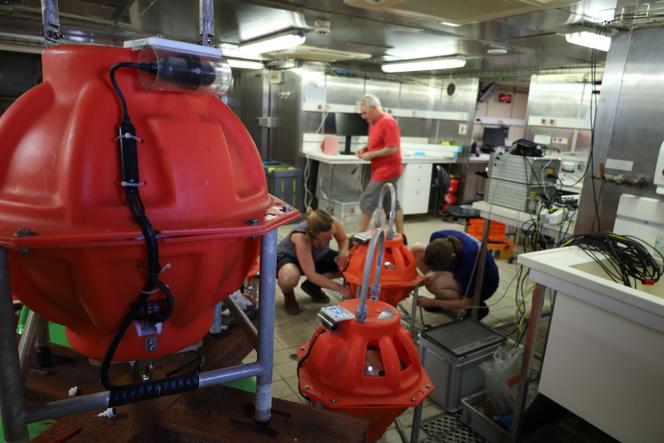


"This marvel could record the movement of a crab walking next to it," said Pascal Pelleau preparing one of the ocean bottom seismometers (OBS) for the plunge. Chief instrumentation engineer on the Pourquoi Pas? ("Why not?"), Pelleau is one of the French Research Institute for Exploitation of the Sea (Ifremer) veterans on board with more than 30 years of service under his belt. "But they have to be calibrated right before we deploy them; we can't just prepare all of them in advance." All the OBSs have an internal quartz clock that is susceptible to temperature differences. To ensure that they undergo as little variation as possible, at most a few hours before the release Pelleau and his team connect the instruments to a device linked to satellites – whose clocks are more stable – that fly over the region, a few hours before the release. "Having them set on the exact satellite time is essential because you need to know precisely when the seismic wave coming from the air gun reaches the OBS," he explained. "We tolerate a variation of the internal clock of max 22 milliseconds per day."
The 65 OBSs of the Haiti Twist campaign are deployed one by one, every 5 kilometers, along a line some 300 kilometers long. There's not much time to relax between each launch, which takes place every 30 to 40 minutes. The specialized staff continuously rotate every four hours for the nearly two days it takes to set up, ensuring that every instrument is ready. Attached to iron anchors, one by one the OBSs are dropped into the sea from a small crane. During the mission to study the seismic faults surrounding Haiti, the deepest OBS deployed touched ground at a depth of 5,500 meters below sea level. This is the limit beyond which it could implode under water pressure. "We baptized that one 'Guardian of the Depths,'" said Chastity Aiken, "You feel more responsible for them when you give them a name."
Once on the seafloor, the seismometers wait in the darkness for the waves generated from the ship's air guns, which will have traveled up to 40 kilometers underground before sending back an echo. But for researchers to extract the data that the OBSs have recorded, the only way is to bring them back to the light.
A hunt at sea begins. From the laboratory, Pascal Pelleau and his team send an acoustic signal of a specific frequency at regular intervals, incorporating a binary code tailored for every OBS. "It's like we make a call to each one with their own phone number," said Pelleau. "Once the OBS hears it, it says 'ok they are calling me!' The internal battery starts sending electrons to a tiny, thin stainless steel plaquette exposed to the water. The electrons speed up the corrosion process of the plaquette, and once it breaks, the OBS detaches from the anchor and begins its ascent." The ballast, left on the seabed, rusts and dissolves after several years.
You have 49.62% of this article left to read. The rest is for subscribers only.
